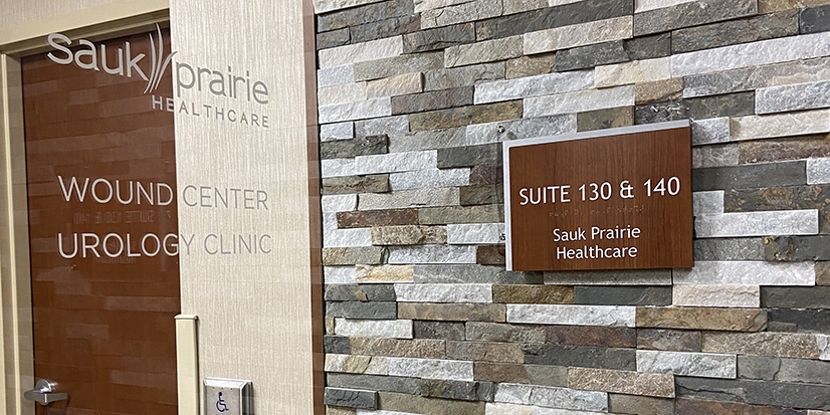
Kidney Stones
Call 608-643-7262 to Schedule a Urology Appointment
Your kidneys are essentially part of your body’s trash collector, which is a very important job. Without your kidneys removing waste products and extra water from your blood as urine, these wastes would build up and damage your body. Instead, the “trash” becomes urine, which flows from the kidneys to the bladder through tubes called ureters.
As your kidneys do their filtering, they’re working hard to maintain the right balance of water, salt and mineral levels in your blood. But that can be thrown off when there’s a high concentration of certain minerals and not enough liquid to water them down in your urine – the ideal environment for kidney stones.
Common Causes of Kidney Stones
The most common cause of kidney stones is dehydration — simply not having enough fluid in your system. This leads to not making enough urine, which in turn can cause the crystallization and making of kidney stones. It’s a little like if you were trying to make a drink from a powder mix and didn’t add enough liquid, leaving behind hardened powder that can’t dissolve. Once a crystal forms, staying dehydrated can cause further crystallization and stone growth.
The minerals that are the biggest culprits when it comes to kidney stones are calcium, oxalate and uric acid. A number of factors can contribute to your likelihood of having kidney stones, including diet, certain medical conditions and medications, obesity and family history.
It’s sometimes tricky to pinpoint the exact reason you formed a kidney stone. And, just the mere existence of kidney stones doesn’t necessarily mean you’ll experience pain or other problems with them. You can actually have stones in your bladder or in your kidney for a long time that never really cause you any pain and, therefore, you may not even be aware of them. It’s when they move somewhere else — such as into the ureter or urinary tract — that they can cause the most trouble.
Types of Kidney Stones
What do kidney stones look like? They can be black, brown, white or yellow, smooth or rough, and range in size from a grain of salt to a golf ball or more. It may depend on the type of kidney stone, which is helpful to understand because the type can affect the treatment necessary. The main kidney stone classifications include:
Calcium Stones:
These are by far the most common, with 80% of kidney stones having calcium as its base. Calcium stones can get their start if you don’t drink enough water, or if you don’t replace the fluids you lose during significant sweating. Also, eating foods high in oxalates or taking unusually high levels of Vitamin D may increase your risk of this type of stone.
Uric Acid Stones:
Similar to calcium stones, uric acid stones can be triggered by not drinking enough water or by significant sweating. A high-protein diet may also contribute to the formation of this stone.
Cystine Stones:
This is the least common type and is typically caused by a genetic predisposition. Once you get a cystine stone, there’s a chance you may have another one.
Struvite Stones:
Infections, especially in the urinary tract, can contribute to this kind of stone.
Symptoms of Kidney Stones
Most kidney stones start out in the kidney. If that stone drops down into the ureter — the tube draining from your kidney to your bladder — it can be extremely uncomfortable. The tube is very small, so a stone may block the flow of urine, even as your body continues to make more urine. The pressure buildup and the accompanying swelling of the kidney ultimately can lead to the painful symptoms of an acute stone episode, often first experienced as side pain.
Kidney stone pain can shift around in your body, moving to your belly or groin if the stone is small enough to keep moving through the ureter and get closer to your bladder. When this happens, you’re more likely to feel a burning when you urinate or have more frequent urges to go. Sometimes, the stone is small enough to pass through while you urinate.
Your symptoms can vary and range in severity, including:
- Pain in your side or back, below the ribs (typically severe)
- Pain in your groin and lower abdomen
- Pain that comes and goes and ranges in severity
- Nausea or vomiting
- Painful or burning urination that is more frequent than usual
- Urine that is cloudy, pink, red or brown, or that has a bad odor
- Feeling like you need to urinate all the time
- Feeling like you’re not emptying your bladder when you do go
- Fever and chills that would signal an infection
Treatment of Kidney Stones and Bladder Stones
Just as the symptoms vary, so does the treatment. Your doctor may order lab testing or scans of your kidney and urinary tract to help pinpoint whether you’re dealing with a stone. For a stone that isn’t giving you too much trouble, the first step may be just to keep an eye on it, and wait a couple weeks for it to pass on its own. In this situation, your doctor might prescribe you something for kidney stone pain relief or even a medication to relax and widen the ureter, helping you pass a kidney stone faster and more easily.
You may also be given a urine strainer to catch the stone when you urinate, or have your urine itself tested, to see if medication may prevent future stones. Also, knowing the type of stone can be helpful in treating future stones. For example, if your stone is made from uric acid, you may be able to use a potassium citrate or sodium citrate solution to dissolve future uric acid stones.
However, if you’re in a great deal of pain, showing signs of infection or unable to urinate, you’ll need immediate relief and medical attention. The best approach in this situation is to break up or remove the stone. Years ago, this likely would have meant a surgical incision, but technological advances now allow a much less invasive approach using miniaturized telescopes and kidney stone laser lithotripsy. Your Urologist passes a thin, flexible scope through your bladder and ureter into your kidney to find and remove stones. If the stone is too large, a laser is used to break it apart. Either way, the stone or its pieces are collected for lab analysis to allow more effective prevention and treatment of future stones.
How to Prevent Kidney Stones
About 50% of patients with a kidney stone get another one within seven years of the first episode. But there are definite things you can do to help keep them at bay, especially once you know the type of stone you had and whether the trouble is rooted in dehydration, diet, medication or another cause that can be addressed accordingly.
People often wonder about the foods that cause kidney stones, the worst drinks for kidney stones and other potential triggers. Here’s a brief overview of some common preventive measures:
- Drinking plenty of liquids: Drink at least 100 ounces of water (including lemonade and other liquids) daily to stay properly hydrated. If you exercise a lot, you’ll need to increase your water intake. Avoid caffeine, which dehydrates you. Also avoid colas, which are high in fructose and phosphates and may also lead to kidney stones.
- Limiting certain “trigger foods”: Even if you’re in good health, your diet may encourage kidney stones to grow. Foods such as animal protein, egg, spinach, beets, chocolate, nuts and colas have been linked to kidney stones. Also, foods high in oxalates — rhubarb, spinach, beets, bran flakes, potato chips and French fries — can be a kidney stone trigger.
- Reducing sodium intake: Lots of sodium can raise calcium levels in your urine, which can in turn cause stones to form. Cutting back on the sodium you get from food and beverages will also help your heart and your blood pressure.
- Getting enough calcium: Yes, calcium stones are the most common type of kidney stone, so we can see why it may be confusing to encourage calcium intake. But eating calcium-rich foods like kale and salmon isn’t a bad thing — only when you also eat too much salt. A lack of calcium can boost the level of oxalates in your urine, which can cause kidney stones.
- Eating citrus fruits: Lemons and limes are high in citrate, which can help prevent kidney stones.
Talk to Our Urologist at Sauk Prairie Healthcare
We know your bodily functions are not always the most comfortable topic for you to talk about, but our Urologist at Sauk Prairie Healthcare specializes in making those conversations easier for you. If you can come to us with early signs of kidney stones, such as discomfort in your side or urinary difficulties, we can identify your stone earlier, closely monitor your progress and offer you the least invasive treatments possible.
Should you need kidney stone surgery, we can take care of that for you quickly and conveniently, right here at our hospital. At Sauk Prairie Healthcare, we offer you the latest technology onsite with a laser capable of treating all stone types — and you typically get to go home the very same day.
There are many options available to you for dealing with and preventing kidney stones. We’re glad to talk through them with you, answer your questions and share our expertise on what will work best for your personal situation.



